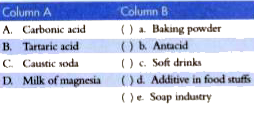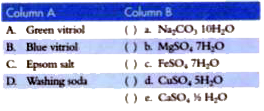Complete Solutions to CONCEPT APPLICATION (LEVEL 1) of chapter ACIDS, BASES AND SALTS of Class 7 book with complete answers and questions
| Class 7 | CHEMISTRY |
| Chapter | ACIDS, BASES AND SALTS |
| PEARSON IIT JEE FOUNDATION | CONCEPT APPLICATION (LEVEL 1) |
| Number Of Questions | 41 |
| Academic Year | 2023-24 |
Hydrochloric acid is a monobasic acid.
00:46View SolutionCarbonic acid is a strong acid.
01:02View SolutionSulphur dioxide on hydrolysis gives sulphuric acid.
01:02View SolutionAcids turn methyl orange solution pink.
01:11View SolutionAmmonium hydroxide is an alkali.
01:15View SolutionLead sulphid is a normal salt.
02:00View SolutionFormula of washing soda is `Na_(2)CO_(3)* 7H_(2)O`.
01:01View SolutionNitre is the common name of sodium nitrate.
00:54View SolutionMercuric nitrate is a deliquescent salt.
02:06View SolutionChile salt petre is used in the manufuacture of nitric acid.
02:01View SolutionHydrochloric acid is a ________ acid. (monobasic/ dibasic)
01:20View SolutionCarbonic acid is a _______ acid. (strong/ weak)
01:58View SolutionSulphur dioxide on hydrolysis gives _________.
01:35View SolutionAcids turns methyl orange solution _________.
01:39View SolutionAmmonium hydroxide is an _______ (acid/ alkali)
01:36View SolutionSodium sulphate is a ______ salt.
02:05View SolutionFormula of washing soda is _________.
02:24View SolutionNitre is the common name of __________.
01:27View SolutionMercuric nitrate is a _________ salt (deliquescent/ efflorescent)
02:12View SolutionChile salt petre is used in the manufuacture of _________ (nitric acid/ nitrous acid)
01:58View SolutionIdentify the organic acid among the following given acids.
03:45View SolutionIdentify the strong acid and weak base among the following respectively.
01:58View Solution`H_(3)PO_(4)` is an example of
01:12View Solution`Ca(OH)_(2)` in an example of
01:12View Solution`CaCl_(2)` is an example of
02:02View SolutionAmong the following, identify an extremely corrosive alkali.
01:58View SolutionGenerally, hydrolysis of metal oxides gives
01:54View SolutionName of the salt formed by treating calcium oxide solution with nitric acid is ________ .
02:19View SolutionFormula of potassium hydrogen sulphite is
00:55View SolutionSmelling salt is
00:59View SolutionDibasic weak mineral acid among the following is
02:39View SolutionIf a nonmetal forms only two oxides and one oxide on hydrolysis gives an acid, then the non-metal could be
03:46View SolutionAntacid pair among the following is
01:53View SolutionWhich among the following is/are poor conductors of electricity?
02:30View SolutionHygroscopic substance among the following is
02:17View SolutionIdentify the pair of water soluble bases.
02:14View SolutionA metallic element is converted into a compound 'A' after a series of reactions. Compound 'A' turns red litmus blue. 'A' on reaction with another compound B which turns blue litmus red gave a compound 'C' which responded to litmus test like compound 'B'. 'C' on further reaction with 'A' gave a compound 'D' Which did not respond to litmus test. Identify the correct sequence of steps for the formation of A, B, C and D.
(a) `NaOH + H_(2)SO_(4) rarr NaHSO_(4) + H_(2)O`
(b) ` 4Na + O_(2) rarr 2Na_(2)O`
(c) `NaHSO_(4) + NaOH rarr Na_(2)SO_(4) + H_(2)O`
(d) `Na_(2)O + H_(2)O rarr 2NaOH`02:41View SolutionArrange the following pairs in a sequence of decreasing order of acidity of base and increasing order of basicity of an acid and the salts formed between an acid and base with equal basicity and acidity in their increasing order, respectively.
(1) sodium chloride.
(2) barium hydroxide and sulphuric acid
(3) ferric phosphate
(4) ferric hydroxide and hydrochloric acid
(5) barium sulphate
(6) sodium hydroxide and phosphoric acid05:12View SolutionMatch the following Column A and Column B
 05:50View Solution
05:50View Solution 05:09View Solution
05:09View Solution 02:47View Solution
02:47View Solution
CONCEPT APPLICATION (LEVEL 1) questions and complete solutions for chapter ACIDS, BASES AND SALTS of PEARSON IIT JEE FOUNDATION of Class 7
All Exercises from PEARSON IIT JEE FOUNDATION Class 7 CHEMISTRY ACIDS, BASES AND SALTS
- ASSEMENT TEST 1
- ASSEMENT TEST 2
- ASSESMENT TEST (TEST 1)
- ASSESMENT TEST (TEST 2)
- CONCEPT APPLICATION (LEVEL 1)
- CONCEPT APPLICATION (LEVEL 2)
- CONCEPT APPLICATION (LEVEL 3)
- ESSAY TYPE QUESTION
- EXAMPLE
- LEVEL -1
- LEVEL -2
- LEVEL -3
- SHORT-ANSWER TYPE QUESTION
- TEST YOUR CONCEPTS
- TEST YOUR CONCEPTS ( SHORT ANSWER TYPE QUESTIONS)
- TEST YOUR CONCEPTS ( VERY SHORT ANSWER TYPE QUESTIONS)
- VERY SHORT-ANSWER TYPE QUESTION
